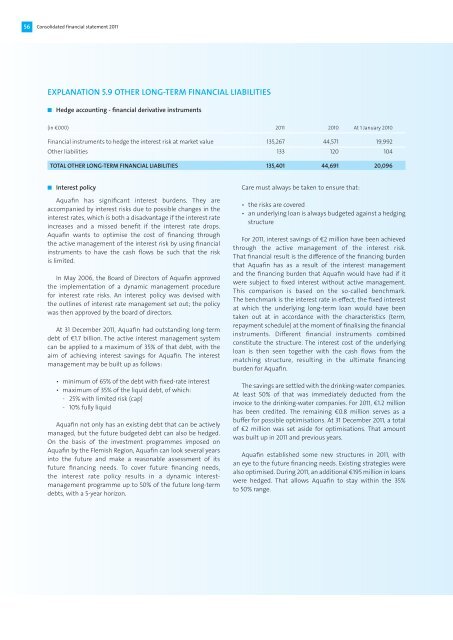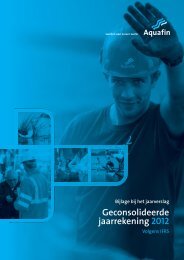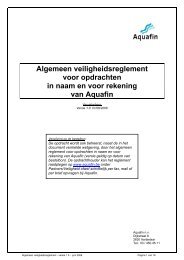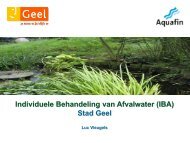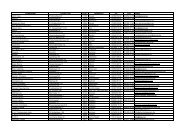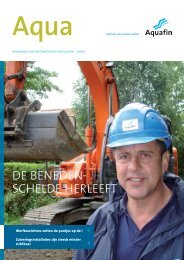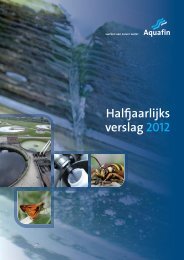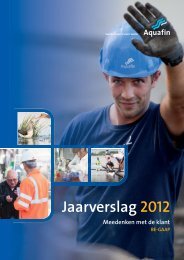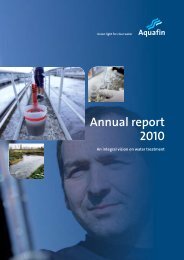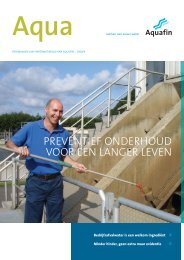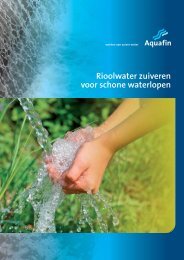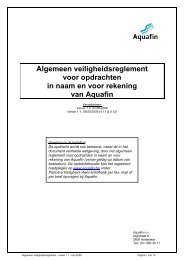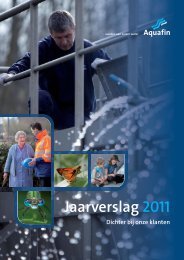Consolidated financial statement 2011 - Aquafin
Consolidated financial statement 2011 - Aquafin
Consolidated financial statement 2011 - Aquafin
Create successful ePaper yourself
Turn your PDF publications into a flip-book with our unique Google optimized e-Paper software.
56<br />
<strong>Consolidated</strong> <strong>financial</strong> <strong>statement</strong> <strong>2011</strong><br />
EXPLANATION 5.9 OTHER LONG-TERM FINANCIAL LIABILITIES<br />
n<br />
Hedge accounting - <strong>financial</strong> derivative instruments<br />
(in €000) <strong>2011</strong> 2010 At 1 January 2010<br />
Financial instruments to hedge the interest risk at market value 135,267 44,571 19,992<br />
Other liabilities 133 120 104<br />
TOTAL OTHER LONG-TERM FINANCIAL LIABILITIES 135,401 44,691 20,096<br />
n<br />
Interest policy<br />
Care must always be taken to ensure that:<br />
<strong>Aquafin</strong> has significant interest burdens. They are<br />
accompanied by interest risks due to possible changes in the<br />
interest rates, which is both a disadvantage if the interest rate<br />
increases and a missed benefit if the interest rate drops.<br />
<strong>Aquafin</strong> wants to optimise the cost of financing through<br />
the active management of the interest risk by using <strong>financial</strong><br />
instruments to have the cash flows be such that the risk<br />
is limited.<br />
In May 2006, the Board of Directors of <strong>Aquafin</strong> approved<br />
the implementation of a dynamic management procedure<br />
for interest rate risks. An interest policy was devised with<br />
the outlines of interest rate management set out; the policy<br />
was then approved by the board of directors.<br />
At 31 December <strong>2011</strong>, <strong>Aquafin</strong> had outstanding long-term<br />
debt of €1.7 billion. The active interest management system<br />
can be applied to a maximum of 35% of that debt, with the<br />
aim of achieving interest savings for <strong>Aquafin</strong>. The interest<br />
management may be built up as follows:<br />
• minimum of 65% of the debt with fixed-rate interest<br />
• maximum of 35% of the liquid debt, of which:<br />
- 25% with limited risk (cap)<br />
- 10% fully liquid<br />
<strong>Aquafin</strong> not only has an existing debt that can be actively<br />
managed, but the future budgeted debt can also be hedged.<br />
On the basis of the investment programmes imposed on<br />
<strong>Aquafin</strong> by the Flemish Region, <strong>Aquafin</strong> can look several years<br />
into the future and make a reasonable assessment of its<br />
future financing needs. To cover future financing needs,<br />
the interest rate policy results in a dynamic interestmanagement<br />
programme up to 50% of the future long-term<br />
debts, with a 5-year horizon.<br />
• the risks are covered<br />
• an underlying loan is always budgeted against a hedging<br />
structure<br />
For <strong>2011</strong>, interest savings of €2 million have been achieved<br />
through the active management of the interest risk.<br />
That <strong>financial</strong> result is the difference of the financing burden<br />
that <strong>Aquafin</strong> has as a result of the interest management<br />
and the financing burden that <strong>Aquafin</strong> would have had if it<br />
were subject to fixed interest without active management.<br />
This comparison is based on the so-called benchmark.<br />
The benchmark is the interest rate in effect, the fixed interest<br />
at which the underlying long-term loan would have been<br />
taken out at in accordance with the characteristics (term,<br />
repayment schedule) at the moment of finalising the <strong>financial</strong><br />
instruments. Different <strong>financial</strong> instruments combined<br />
constitute the structure. The interest cost of the underlying<br />
loan is then seen together with the cash flows from the<br />
matching structure, resulting in the ultimate financing<br />
burden for <strong>Aquafin</strong>.<br />
The savings are settled with the drinking-water companies.<br />
At least 50% of that was immediately deducted from the<br />
invoice to the drinking-water companies. For <strong>2011</strong>, €1.2 million<br />
has been credited. The remaining €0.8 million serves as a<br />
buffer for possible optimisations. At 31 December <strong>2011</strong>, a total<br />
of €2 million was set aside for optimisations. That amount<br />
was built up in <strong>2011</strong> and previous years.<br />
<strong>Aquafin</strong> established some new structures in <strong>2011</strong>, with<br />
an eye to the future financing needs. Existing strategies were<br />
also optimised. During <strong>2011</strong>, an additional €195 million in loans<br />
were hedged. That allows <strong>Aquafin</strong> to stay within the 35%<br />
to 50% range.


